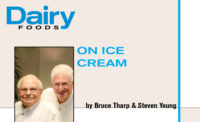Any discussion on the shelf life of ice cream would do well to include planned variants with added inclusions. Often shelf-life studies cover only straight vanilla or chocolate, then other added flavors as part of any final product line.
Shelf life for the entire line might be considered for products with inclusions. All products within the product line are assigned the same shelf life, which adds some degree of inherent error. End of shelf life is determined by the feature, or fact, that fails first. In many instances, products with inclusions tend to fail first.
Foods might fall short of consumer expectations based on one or more factors. Some of these might include:
-
Appearance (color, form, format, shrinkage).
-
Aroma (some element of volatiles that contribute to any final flavor).
-
Taste (sweet, salty, bitter, sour/tart, “umami,” recently identified “fatty” taste).
-
Texture (smooth, creamy, coarse, icy, sandy).
-
Temperature of consumption.
Any failures of one or more of these features — or influences on these traits — could render the final ice cream short of meeting expectations and, therefore, define the end of shelf life. Since ice cream is the only food designed, formulated, manufactured, distributed, and sold with the express intent of being consumed frozen, the implication is that the textural shelf life, the ability to “physically survive” repeated and, most times, unknown episodes of heat shock across the intended shelf life of the product line is critical.
Ultimately, any initial shelf-life projections of any given ice cream or line of ice creams are arbitrary, but also critical to the management of the line. There always is a balance between what marketing and/or sales wants versus product(s) that fulfill their textural integrity through the full intended declared shelf life.
Ice cream eating “quality” is first described in textural terms such as “smooth,” or “creamy” before any failures related to flavors /off-flavors can be fully identified or described. This makes loss of textural shelf life critical to setting any final shelf-life expectations.
In addition, “textural” shelf life can be managed objectively and analytically, whereas flavors and colors are far more subjective. All of this becomes more complicated when bulky inclusions such as syrups and particulates are considered.
Key to this is understanding the amount/type of inclusions to be considered and the where/how inclusions of any type might be likely to cause “failure.” For simplicity, this is broken down into method(s) of introduction.
Particulates: These include nuts, chips, cookies and fruit pieces, usually added to ice cream at the fruit feeder. In some cases, these might be added directly to the flavor vat.
Particulates are almost always added at temperatures higher than the soft ice cream into which they are added. Given this reality, localized melting of the ice cream is immediately caused in the vicinity of the particulate(s).
This does not often affect the shelf life in a significant way, but there are exceptions. For instance, a salted piece such as a roasted pecan or a praline will partially desiccate the immediate vicinity around it, pulling water out of the surrounding ice cream and causing crystallization of lactose in the ice cream. This lactose crystallization is a defect called “sandiness” and is almost sure to occur with these types of particulates over time.
Another example: the addition of high-sugar-content strawberry puree, which will tend to separate from the ice cream during storage, producing a sticky mess at the bottom of the container.
Syrups: Certain variegates and sauces such as caramels and fudge are pumped into the ice cream via co-extrusion at the filler. Often these syrups are between 40 degrees and 70 degrees Fahrenheit; as such, they add heat and produce localized melting in the ice cream. If not properly considered or formulated, the variegate could easily retreat from the ice cream across storage, causing unsightly coarse/icy voids in the final food.
Flavors: Simple liquid flavor extracts will not have much effect on shelf life. However, when “compounded flavorants” are used and added at the flavor vat, they could disrupt the freezing point of the flavored mix, initiating early shelf-life failure. In addition, this could reduce the effectiveness of stabilizer(s) by simple dilution, resulting in “shrinkage.”
The above applies to the final ice cream as a whole, but could apply to any of the given particulates or syrups themselves. Particulates might get soft or mushy; syrups might get dry, stiff or “short.” This does not take into account any given inclusion’s inherent shelf life before being added to ice cream.
In nearly all cases, inclusions of any type/amount will directly, or indirectly, reduce a defined textural shelf life of any ice cream into which they are added. This ignores their own textural shelf-life issues.
Thus, products with inclusions are more sensitive to shelf-life considerations and will dictate the final shelf-life expectation of the full product line into which they are marketed for sale. That is, in any given product line, the product that “fails first” is most likely the variant with the most inclusions, most varied type of inclusions and inclusions that can negatively influence (allow) excess mobility of free water during expectant and repeated episodes of heat shock.
There is a lot to consider.



